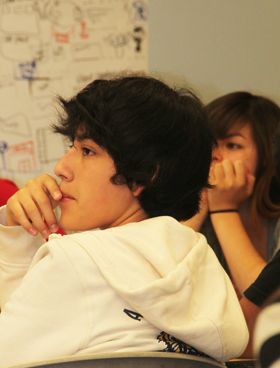
East L.A. (left) took on a different look when high school students in an urban planning workshop at UCLA mapped their neighborhood, showing their school, a nearby park, gang hangouts and a roaring freeway ramp.
The exercise was part of the Urban Planning Youth Empowerment Conference hosted Friday, April 12, by the UCLA Luskin School of Public Affairs. The first of its kind, the event was organized by a Luskin graduate student group after second-year urban planning graduate student Osvaldo Garcia learned about the academy, one of only three high school programs in the nation with a focus on urban planning.
"I didn’t even know about [urban] planning until about two months before applying to [UCLA’s] program," admitted Garcia, a member of the student group, Planners of Color for Social Equity, and a leader of one of the morning's map-making sessions. The conference gave high school students a real-world look at the profession of urban planning and the opportunities it offers to make a difference in the world.  Heading up another mapping session was second-year graduate student Hector Gutierrez, who studies community and economic development.
Heading up another mapping session was second-year graduate student Hector Gutierrez, who studies community and economic development.

Students in graduate student Hector Gutierrez's class anchor their map with busy Cesar Chavez Highway, located a block from their school.
"What do you see?" Gutierrez asked the teens as they worked in teams on their maps. "What do you hear? What do you feel when you walk your community?"
"I see McDonald’s," one girl announced to her team. "I’m going to draw a big old ‘M.’" Classmates added a picture of their school, a Jack in the Box, a liquor store and an alleyway with a stick figure of someone "smoking weed," along with a dead body, the victim of a crime. One student drew an overhead freeway ramp that leads to the massive 710 Long Beach Freeway. "I live next to it," he said. A classmate added a homeless man living under the ramp.
Next, Gutierrez invited the students to take a look at all of the maps that had been drawn, noting similarities and differences and adding things that were missing. One girl observed of another team’s depiction, "They need cholos." She drew an angry-faced gang member in front of a store.  Gutierrez and his fellow instructors expanded upon the students’ hand-drawn maps by introducing them to computer-generated maps that incorporated demographic data such as crime and income levels.
Gutierrez and his fellow instructors expanded upon the students’ hand-drawn maps by introducing them to computer-generated maps that incorporated demographic data such as crime and income levels.

Urban planners, said Gutierrez, are always asking themselves, "How can we build a better urban environment for the people we serve?"
One map showed in various shades of green the rate of violent crime in the vicinity of their school. Gutierrez asked, "Who knows what’s meant by ‘violent crime?’"
The answers came easily: Murder. Rape. Abuse. Fights.
"The darker the green [on the map], the more the crime," Gutierrez explained, pointing to the solid dark-green block around their school.
"Oh, snap!" one boy responded. "Damn!" said another.
"How does this make you feel?" Gutierrez inquired.  A black-and-orange map indicated the median household income in communities. "Boyle Heights has a median income of $36,000. The median income of Los Angeles is $56,000," Gutierrez said. "Do you think a family can live on $36,000?" he asked, prompting a discussion on poverty and its causes, from drug addiction to a lack of jobs.
A black-and-orange map indicated the median household income in communities. "Boyle Heights has a median income of $36,000. The median income of Los Angeles is $56,000," Gutierrez said. "Do you think a family can live on $36,000?" he asked, prompting a discussion on poverty and its causes, from drug addiction to a lack of jobs.
"Not safe," someone said. "Sad," said someone else.

Students were introduced to demographic maps that show that the violent crime rate in their neighborhood is among the highest in the city.
This workshop was also about coming up with solutions, Gutierrez said. "As urban planners, we ask ourselves, ‘How can we build a better urban environment for the people we serve? What would you do to improve your community?’"
His students suggested building more medical clinics, installing more security cameras and adding more parks and sports facilities to keep kids out of gangs.
Students in Garcia’s workshop suggested bringing in more public transportation to encourage business development, along with more bike and carpool lanes to "keep it green." More parks, swimming pool and libraries would help, they suggested. And a homeless shelter. "There are too many homeless people," one student explained. "Maybe we can build a homeless shelter with a hospital and rehab center together – there are a lot of crack addicts."  "That’s planning," said Garcia.
"That’s planning," said Garcia.

Jesus Palalia, a ninth grader, drew an overhead freeway ramp that runs right near his home.
Despite their numerous concerns, many of the students also expressed pride in their community coupled with a desire to make positive changes.
"Do not be afraid to speak up; speak your mind," said Gutierrez, who encouraged them to become involved with community organizing and familiarize themselves with their city councilmember and other leaders.
Most importantly, "All of you should be going to college," said Gutierrez, who found his way to UCLA after growing up in California’s Central Valley, where he witnessed the struggles of hardworking agricultural laborers. "You guys are some of the most intelligent people out there. You can do whatever you want."
________________________________________________________________________________________________________________________________________
This story was adapted from a UCLA Luskin School of Public Affairs website story.




